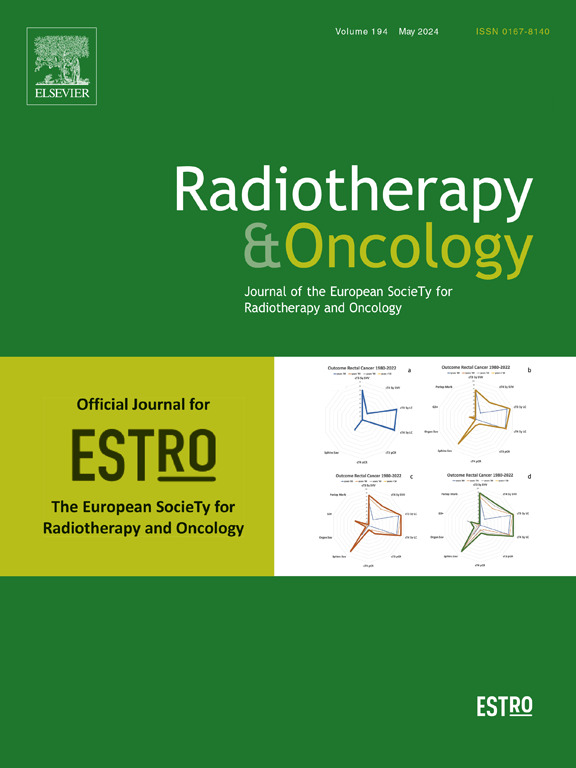Impact of the Common Terminology Criteria for Adverse Events (CTCAE) evolution on toxicity scoring in gynaecological radiotherapy
IF 4.9
1区 医学
Q1 ONCOLOGY
引用次数: 0
Abstract
Purpose
The Common Terminology Criteria for Adverse Events (CTCAE) is the established toxicity scoring system that assigns severity grades (G1 = mild to G5 = death) to Adverse Events (AEs). Compared to CTCAE v3.0 (2006), updated versions introduced changes in severity grade definitions. This study evaluated changes between v3.0 and v5.0 (2017) for AEs in gynaecological radiotherapy.
Material and methods
After selecting AEs relevant for gynaecological radiotherapy in v3.0, changes in severity grades were identified using CTCAE v3.0-to-v5.0 mapping tables. Six radiation oncologists (ROs) evaluated severity grade definitions for changes in: clinical interpretation, subjective (patient-reported symptoms) and objective (details on medication/intervention) information, and expected severe (≥G3) events. Agreement was based on at least five (≥5)ROs.
Results
Gastrointestinal, urinary, reproductive, general and injury/musculoskeletal AEs were selected (n = 118). G4 definitions in v5.0 were removed in 22 % of AEs. ≥5ROs agreed on changes affecting clinical interpretation especially for G2 (31 %) and G3 (30 %). For subjective information, 18 % of G2 and 15 % of G3 were judged relying more on patient-reported symptoms. Less objective information was found in 51 % of G3 definitions. Variability in agreement was observed especially for subjective information in G3 and expected ≥G3 events.
Conclusion
This analysis revealed that severity grade definitions in v3.0 and v5.0 for AEs in gynaecological radiotherapy present changes with potential impact on scoring in clinical studies. Notably, 22 % of AEs in v5.0 no longer have G4 defined, and G3 definitions often include fewer details on medication/intervention. Variability in ROs’ interpretations is frequently observed, highlighting the need for education to standardise toxicity scoring.
不良事件通用术语标准(CTCAE)演变对妇科放疗毒性评分的影响
不良事件通用术语标准(CTCAE)是既定的毒性评分系统,将严重程度等级(G1 =轻度至G5 =死亡)分配给不良事件(ae)。与CTCAE v3.0(2006)相比,更新版本引入了严重等级定义的变化。本研究评估了v3.0和v5.0(2017)在妇科放疗中ae的变化。材料与方法选择与v3.0妇科放疗相关的ae后,使用CTCAE v3.0- v5.0制图表识别严重程度等级的变化。六名放射肿瘤学家(ROs)评估了严重程度等级定义的变化:临床解释、主观(患者报告的症状)和客观(药物/干预的细节)信息,以及预期的严重(≥G3)事件。至少有5个(≥5个)ROs符合。结果选择胃肠道、泌尿、生殖、一般和损伤/肌肉骨骼ae (n = 118)。v5.0中的G4定义在22%的ae中被删除。≥5ro同意影响临床解释的变化,特别是G2(31%)和G3(30%)。对于主观信息,18%的G2和15%的G3更依赖于患者报告的症状来判断。在51%的G3定义中发现较少的客观信息。特别是在G3事件和预期≥G3事件的主观信息方面,观察到一致性的差异。结论本分析显示,在临床研究中,v3.0和v5.0对妇科放疗ae的严重程度分级定义存在变化,并可能对评分产生影响。值得注意的是,v5.0中22%的ae不再定义G4,而G3定义通常包含较少的药物/干预细节。经常观察到活性氧解释的可变性,强调需要进行教育以标准化毒性评分。
本文章由计算机程序翻译,如有差异,请以英文原文为准。
求助全文
约1分钟内获得全文
求助全文
来源期刊

Radiotherapy and Oncology
医学-核医学
CiteScore
10.30
自引率
10.50%
发文量
2445
审稿时长
45 days
期刊介绍:
Radiotherapy and Oncology publishes papers describing original research as well as review articles. It covers areas of interest relating to radiation oncology. This includes: clinical radiotherapy, combined modality treatment, translational studies, epidemiological outcomes, imaging, dosimetry, and radiation therapy planning, experimental work in radiobiology, chemobiology, hyperthermia and tumour biology, as well as data science in radiation oncology and physics aspects relevant to oncology.Papers on more general aspects of interest to the radiation oncologist including chemotherapy, surgery and immunology are also published.
 求助内容:
求助内容: 应助结果提醒方式:
应助结果提醒方式:


